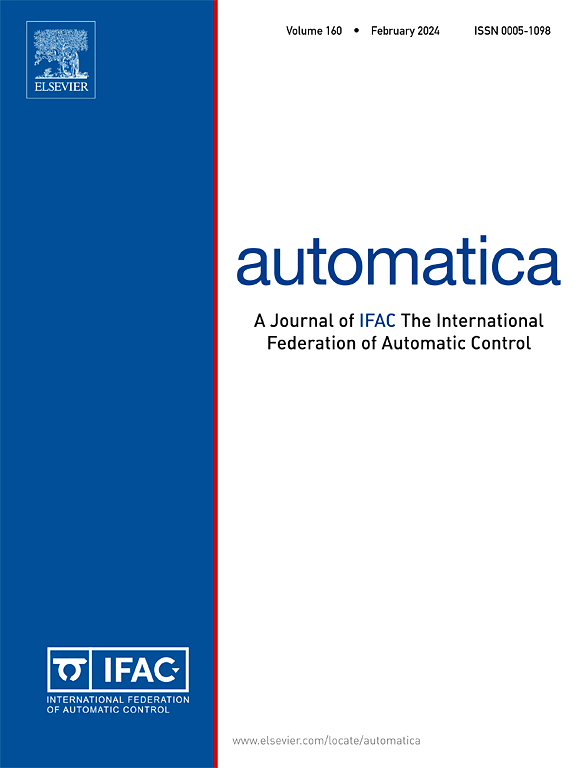计算复杂度为O(n)的时变凸优化
IF 4.8
2区 计算机科学
Q1 AUTOMATION & CONTROL SYSTEMS
引用次数: 0
摘要
本文研究了代价函数随时间变化的无约束时变凸优化问题。我们对问题进行了深入的技术分析,并论证了为什么离散化和冻结每个时间步骤的成本,并采取有限的步骤来最小化并不是这个问题的最佳跟踪解决方案。我们提出了一套算法,通过考虑成本的时间变化,旨在减少问题的时变最小器的跟踪误差。我们工作的主要贡献是,我们提出的算法只需要成本函数对决策变量的一阶导数。与现有算法相比,该方法显著降低了计算成本,而现有算法使用的是成本的逆Hessian。具体而言,所提出的算法将每个时间步的计算成本从O(n3)降低到O(n),其中n为决策变量的大小。避免了Hessian的逆也使我们的算法适用于非凸优化问题。我们把这些算法称为O(n)算法。这些O(n)算法的设计是为了根据有关成本的可用时间信息来解决不同场景的问题。我们通过各种例子来说明我们的结果,包括一个模型预测控制问题的解决方案,该问题被框架为具有流时变成本函数的凸优化问题。本文章由计算机程序翻译,如有差异,请以英文原文为准。
Time-varying convex optimization with O(n) computational complexity
In this article, we consider the problem of unconstrained time-varying convex optimization, where the cost function changes with time. We provide an in-depth technical analysis of the problem and argue why discretizing and freezing the cost at each time step and taking finite steps towards the minimizer is not the best tracking solution for this problem. We propose a set of algorithms that by taking into account the temporal variation of the cost aim to reduce the tracking error of the time-varying minimizer of the problem. The main contribution of our work is that our proposed algorithms only require the first-order derivatives of the cost function with respect to the decision variable. This approach significantly reduces computational cost compared to the existing algorithms, which use the inverse of the Hessian of the cost. Specifically, the proposed algorithms reduce the computational cost from to per timestep, where is the size of the decision variable. Avoiding the inverse of the Hessian also makes our algorithms applicable to non-convex optimization problems. We refer to these algorithms as -algorithms. These -algorithms are designed to solve the problem for different scenarios based on the available temporal information about the cost. We illustrate our results through various examples, including the solution of a model predictive control problem framed as a convex optimization problem with a streaming time-varying cost function.
求助全文
通过发布文献求助,成功后即可免费获取论文全文。
去求助
来源期刊

Automatica
工程技术-工程:电子与电气
CiteScore
10.70
自引率
7.80%
发文量
617
审稿时长
5 months
期刊介绍:
Automatica is a leading archival publication in the field of systems and control. The field encompasses today a broad set of areas and topics, and is thriving not only within itself but also in terms of its impact on other fields, such as communications, computers, biology, energy and economics. Since its inception in 1963, Automatica has kept abreast with the evolution of the field over the years, and has emerged as a leading publication driving the trends in the field.
After being founded in 1963, Automatica became a journal of the International Federation of Automatic Control (IFAC) in 1969. It features a characteristic blend of theoretical and applied papers of archival, lasting value, reporting cutting edge research results by authors across the globe. It features articles in distinct categories, including regular, brief and survey papers, technical communiqués, correspondence items, as well as reviews on published books of interest to the readership. It occasionally publishes special issues on emerging new topics or established mature topics of interest to a broad audience.
Automatica solicits original high-quality contributions in all the categories listed above, and in all areas of systems and control interpreted in a broad sense and evolving constantly. They may be submitted directly to a subject editor or to the Editor-in-Chief if not sure about the subject area. Editorial procedures in place assure careful, fair, and prompt handling of all submitted articles. Accepted papers appear in the journal in the shortest time feasible given production time constraints.
 求助内容:
求助内容: 应助结果提醒方式:
应助结果提醒方式:


